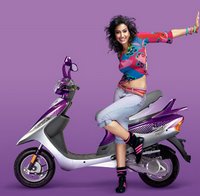Company: Loreal
Brand Count 164
Body Shop is a brand with a difference. Marketers consider this brand as an Icon. Body Shop has created a brand image without the aid of conventional advertising.2006 saw this iconic brand draw up serious business plans for India.
Body Shop brand was created in 1976 in Brighton United Kingdom. The brand and the brand owner share a comm
 on personality that is very much linked to each other. Anita Roddick the legendary founder of the Brand created this brand from a small shop in
on personality that is very much linked to each other. Anita Roddick the legendary founder of the Brand created this brand from a small shop in UK started to support her family.
UK started to support her family.Body Shop in India is sold through the master franchise Planet Sports . The brand is expecting to ramp up the operations to major metros by the year 2008.
Body Shop is differentiated from other conventional cosmetics by the values that the brand adheres to and the brand image created through the unique association with those values.
The brand is famous for its association with ethical practices and the environment friendly world view. The products reflects these values through the use of only natural ingredients and the products are never tested on animals.The packaging and the merchandising are carefully prepared to highlight the brand values. For example , Body Shop uses refillable packs and recycled /recyclable papers. Although the use of refillable packs were used to keep the price low, it evolved into an element that reinforced the brand positioning. The brand also was careful in the messages displayed in the shop and other POP merchandises. The messages were simple, enthusiastic and informative. These elements made Body Shop a different cosmetic brand.
The brand was essentially an extension of the founder herself. Anita Roddick is an ardent environmentalist and naturalist. Her views about the nature supported with her activities and associations created a positive reinforcement for the brand. Customers were seeing a brand that does things while others just give hope. More over Body Shop was able to communicate with the custo
 mers at a higher level rising above beauty and fairness that other cosmetics talked about. There was honesty associated with the brand. The shops also reinforced this attribute. All the shops reflected an environment of honesty, excitement and fun. It is reported that Ms Anita Roddick takes personal interview with the franchises to ensure that they share the same passion with Body Shop principle.
mers at a higher level rising above beauty and fairness that other cosmetics talked about. There was honesty associated with the brand. The shops also reinforced this attribute. All the shops reflected an environment of honesty, excitement and fun. It is reported that Ms Anita Roddick takes personal interview with the franchises to ensure that they share the same passion with Body Shop principle.Although Body Shop is starting serious business with Indian consumers only now, the association with India dates back to the initial years itself. India was a sourcing partner for Body Shop during the creation of the brand.
The success of the brand was because of the unique business model of Body Shop. The brand relies on PR and word of mouth to make sales. The Indian launch was also a low profile one . The brand has gone against most of the conventional marketing practices. The products are simple and the new product ideas are derived from the wisdom of the ordinary people. For example, When the founder was traveling in Srilanka she found women rubbing their faces with freshly cut pineapple flakes that gave a special look to the faces. This translated to a product Body Shop Pineapple face wash. Many products were resulted from this experiences of the founder from the numerous trip she made around the world.
In 2006, Body Shop was acquired by Loreal for 650mn Pounds. Body Shop will function as an independent entity retaining the management and the principles that made this brand an icon.
In India too the brand is expected to appeal to a niche market. Niche in the sense that the level of awareness about "environment friendly" and " ethical" product positioning is a novelty in India. We often relate environment friendliness with unprofitablity while the basic principle of Body Shop is " Profit with Principle" . Another factor is that in India, celebrities are not associated with nature activism. We have the prominent naturalists in Medha Padhkar and Baba Amte and not AB or Susmita Sen.
In the market where high decibel advertising and sales promotion rules, it will be interesting to see how Body Shop will gain the iconic status it deserves in the Indian market.
Source:Harvardbusinessreview,strategicbusinessmanagement(keller),
bodyshopinternational.com,businessline.
bodyshopinternational.com,businessline.










